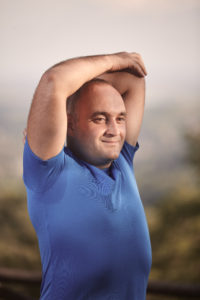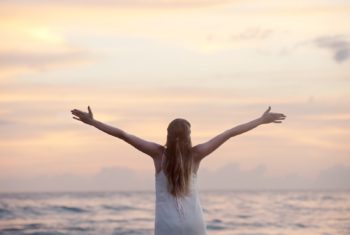By Laura Grottano
Things get turbulent at times for everyone, on and off the water, so it’s important to be prepared for whatever bumps lie ahead.
As experienced captains know, it is better to accommodate the motion of rough seas with flexibility rather than remain rigid and unwavering. Leaving zero room to maneuver likely puts skippers at the mercy of severe conditions — the best-case scenario finds them a bit bruised while the worst case is truly bad.
Just as no one wants to end up battered on the water, no one relishes landing on their rear end ashore. The more effective approach to weathering whatever choppiness daily life throws at you is to bring a spring to your body and move with the  motion of the force. In other words, become flexible!
motion of the force. In other words, become flexible!
Physical flexibility is the ability to bend and reach, to lean and sway, to become pliable and limber in movement. Stretching regularly helps you become more flexible over time and provides better overall support to joints and muscles. These benefits are invaluable for boating, as routine activities aboard require continuous balancing, reaching, twisting, and bending movements. Basic actions like balancing on a gunwale, reaching for a canvas, hoisting a sail, lowering an anchor, twisting to tie off lines, or bending to raise the bumpers are easier with a flexible body.
Stretching trains muscles to distribute workload more efficiently among other areas of the body. This collaboration is essential to avoid injury and achieve a greater range of movement and balance. Reflexive muscles are quicker to respond and retract, in turn increasing performance and stability.
Boaters require constant recalibration among muscle groups to remain balanced in unstable environments. Even sitting on a floating vessel requires an adjusted level of proficiency at equalizing. Without flexibility, a day on the water can end with tight muscles and resulting discomfort or even injury. Tight shoulders lead to tense neck muscles, headaches, and other common issues such as lower back pain, stiff necks, and shoulder problems. Stretching these areas leads to integrated relief throughout the body.
When our muscles are tense, our body sends an urgent message to our brain to be alert. Our mind then prepares and responds by initiating a (usually) inappropriate chemical release, ultimately increasing stress levels. The good news is that we are able to influence our body/mind messaging and set a new transmission code. Physical flexibility translates into mental ease. Our body and mind are eternally connected — what one says causes the other to respond.
As a cert ified yoga teacher, I’ve heard people say “I can’t touch my knees, never mind my toes,” but they find that forward folds stretch their hamstrings, calves, and quadriceps, reducing strain in the lower back. [Editor’s note: always discuss the feasibility of exercise with your doctor before starting any new routine.]
ified yoga teacher, I’ve heard people say “I can’t touch my knees, never mind my toes,” but they find that forward folds stretch their hamstrings, calves, and quadriceps, reducing strain in the lower back. [Editor’s note: always discuss the feasibility of exercise with your doctor before starting any new routine.]
Forward folds should be done at the level that is right for your physical state at the moment that you are doing the exercise. Begin with a soft bend to the knees and a shallow bend forward. After establishing a sense of self-wellness by noting comfort to the legs, back, and neck — and making sure you aren’t dizzy — begin to invite straighter knees and a flatter back to deepen the stretch. Start with three sets of forward folds. Inhale for a slow count of three and exhale for slow count of four. Progress to four sets, using a four-count breath inhale, five-count breath exhale. Increase length of holding as is suitable.
Regular stretching is a physical relaxer that affects our mind just as meditation calms the mind and affects the body. Utilizing both techniques will improve flexibility and ease in mind and body. To begin, stretch out the rigidity in your body and welcome flexibility into your life whether it is a boating day or not. You’ll find a new ease that avoids stiffness and injury and supports you through a more pleasurable journey, be it by land or by sea!
![]()
Additional simple stretches
Laura Grottano is a certified yoga instructor and life-coach who is passionate about inspiring people to generate balance and success in their lives. Utilizing the two specialties, clients will learn how to expand the body and the belief systems that restrain them in order to live an empowered and purposeful life. To learn more go to Mindfulcalm.com or email Laura at Lauragrottano@yahoo.com.
Below are simple and useful warm-up stretches along with forward folds. Begin a practice of stretching regularly, but always stretch at the level that is right for your own physical state on the day and at the moment that you are doing the exercise.
Side bends can be done sitting, lying down, or standing. If standing, use an imaginary wall behind your back as a guide to keep your body aligned. This may significantly decrease your reach (most people will fall forward instead of stay on plane in a side




